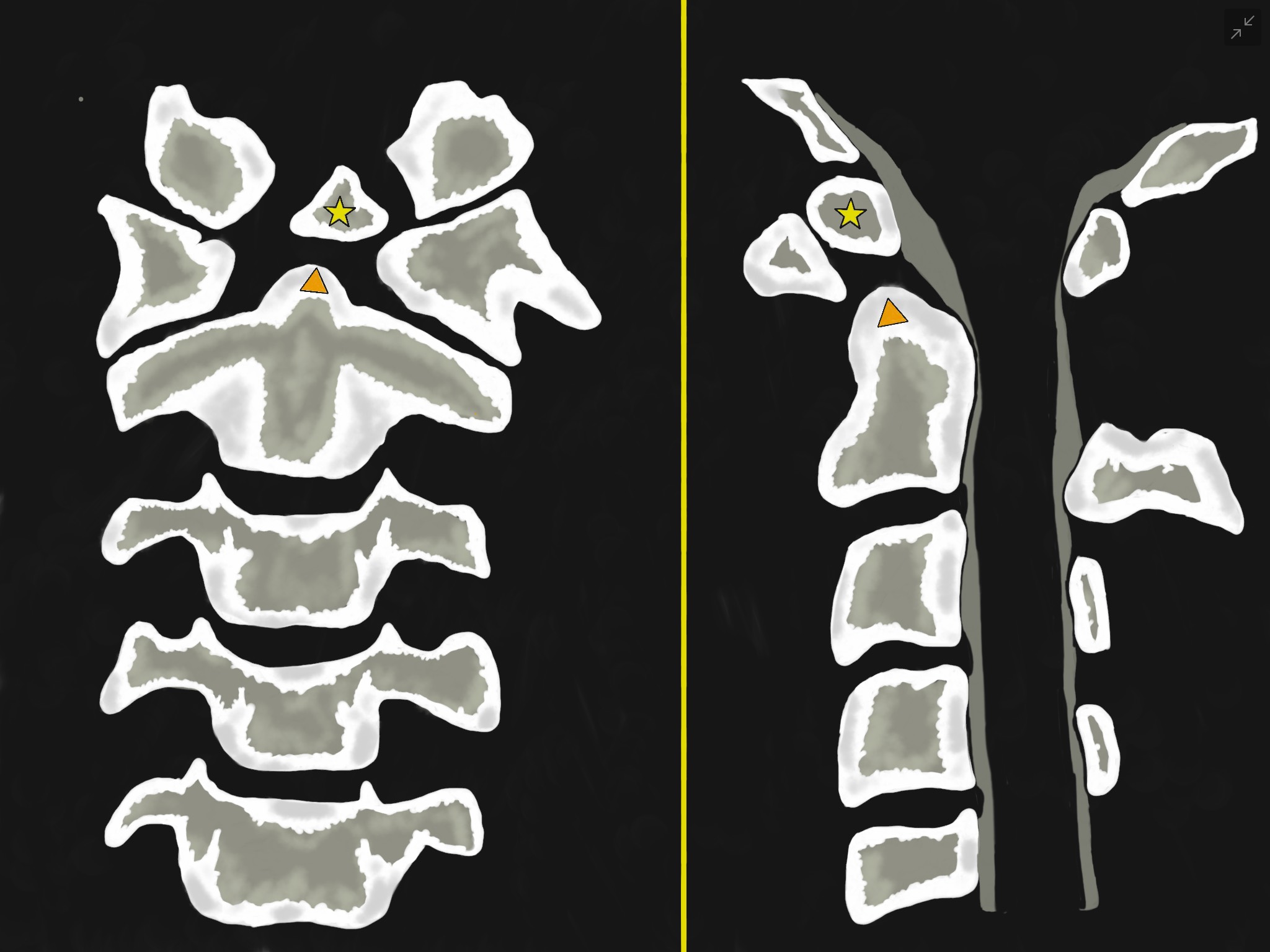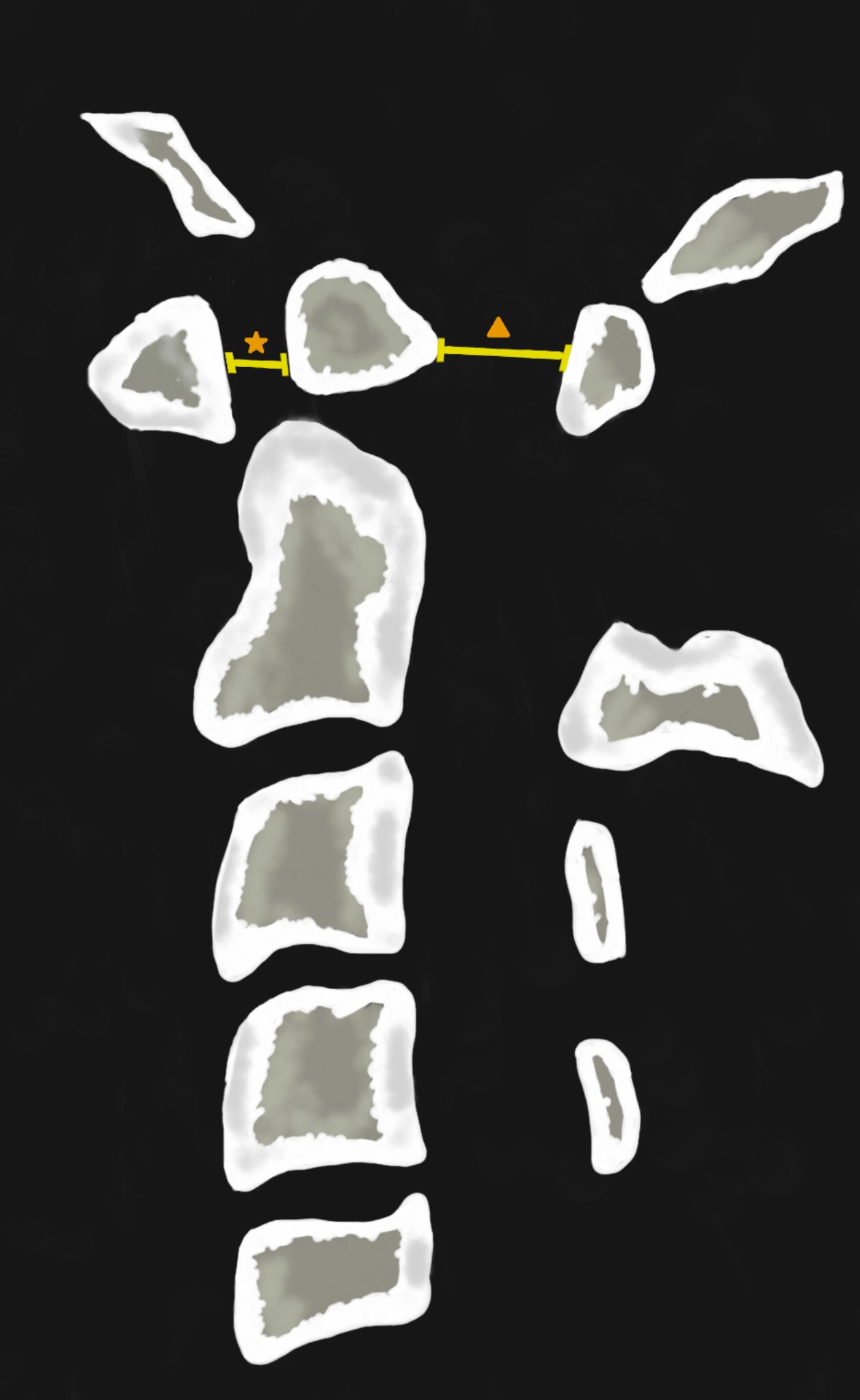[1]
Perrini P, Montemurro N, Iannelli A. The contribution of Carlo Giacomini (1840-1898): the limbus Giacomini and beyond. Neurosurgery. 2013 Mar:72(3):475-81; discussion 481-2. doi: 10.1227/NEU.0b013e31827fcda3. Epub
[PubMed PMID: 23208067]
[2]
Spierings EL, Braakman R. The management of os odontoideum. Analysis of 37 cases. The Journal of bone and joint surgery. British volume. 1982:64(4):422-8
[PubMed PMID: 7096415]
Level 3 (low-level) evidence
[3]
Matsui H, Imada K, Tsuji H. Radiographic classification of Os odontoideum and its clinical significance. Spine. 1997 Aug 1:22(15):1706-9
[PubMed PMID: 9259779]
[4]
Klassov Y, Benkovich V, Kramer MM. Post-traumatic os odontoideum - case presentation and literature review. Trauma case reports. 2018 Dec:18():46-51. doi: 10.1016/j.tcr.2018.11.004. Epub 2018 Nov 27
[PubMed PMID: 30533483]
Level 3 (low-level) evidence
[5]
Arvin B, Fournier-Gosselin MP, Fehlings MG. Os odontoideum: etiology and surgical management. Neurosurgery. 2010 Mar:66(3 Suppl):22-31. doi: 10.1227/01.NEU.0000366113.15248.07. Epub
[PubMed PMID: 20173524]
[6]
Robson KA. Os odontoideum: rare cervical lesion. The western journal of emergency medicine. 2011 Nov:12(4):520-2. doi: 10.5811/westjem.2011.4.2029. Epub
[PubMed PMID: 22224150]
[7]
Fielding JW, Hensinger RN, Hawkins RJ. Os Odontoideum. The Journal of bone and joint surgery. American volume. 1980 Apr:62(3):376-83
[PubMed PMID: 7364809]
[8]
Hedequist DJ, Mo AZ. Os Odontoideum in Children. The Journal of the American Academy of Orthopaedic Surgeons. 2020 Feb 1:28(3):e100-e107. doi: 10.5435/JAAOS-D-18-00637. Epub
[PubMed PMID: 31977608]
[9]
Pluemvitayaporn T, Kunakornsawat S, Piyaskulkaew C, Pruttikul P, Pongpinyopap W. Chronic posterior atlantoaxial subluxation associated with os odontoideum: a rare condition. A case report and literature review. Spinal cord series and cases. 2018:4():110. doi: 10.1038/s41394-018-0143-y. Epub 2018 Dec 19
[PubMed PMID: 30588336]
Level 3 (low-level) evidence
[10]
Nguyen JC, Pollock AN. Os odontoideum. Pediatric emergency care. 2015 Mar:31(3):225-7. doi: 10.1097/PEC.0000000000000411. Epub
[PubMed PMID: 25738246]
[11]
Tang X, Tan M, Yi P, Yang F, Hao Q. Atlantoaxial dislocation and os odontoideum in two identical twins: perspectives on etiology. European spine journal : official publication of the European Spine Society, the European Spinal Deformity Society, and the European Section of the Cervical Spine Research Society. 2018 Jul:27(Suppl 3):259-263. doi: 10.1007/s00586-017-5116-5. Epub 2017 May 15
[PubMed PMID: 28508240]
Level 3 (low-level) evidence
[12]
Fielding JW, Griffin PP. Os odontoideum: an acquired lesion. The Journal of bone and joint surgery. American volume. 1974 Jan:56(1):187-90
[PubMed PMID: 4812163]
[13]
Schuler TC, Kurz L, Thompson DE, Zemenick G, Hensinger RN, Herkowitz HN. Natural history of os odontoideum. Journal of pediatric orthopedics. 1991 Mar-Apr:11(2):222-5
[PubMed PMID: 2010525]
[14]
Verska JM, Anderson PA. Os odontoideum. A case report of one identical twin. Spine. 1997 Mar 15:22(6):706-9
[PubMed PMID: 9089945]
Level 3 (low-level) evidence
[15]
Wang S, Wang C. Acquired os odontoideum: a case report and literature review. Child's nervous system : ChNS : official journal of the International Society for Pediatric Neurosurgery. 2012 Feb:28(2):315-9. doi: 10.1007/s00381-011-1642-3. Epub 2011 Dec 2
[PubMed PMID: 22134416]
Level 3 (low-level) evidence
[16]
Zygourakis CC, Cahill KS, Proctor MR. Delayed development of os odontoideum after traumatic cervical injury: support for a vascular etiology. Journal of neurosurgery. Pediatrics. 2011 Feb:7(2):201-4. doi: 10.3171/2010.11.PEDS10289. Epub
[PubMed PMID: 21284467]
[17]
Wada E, Matsuoka T, Kawai H. Os odontoideum as a consequence of a posttraumatic displaced ossiculum terminale. A case report. The Journal of bone and joint surgery. American volume. 2009 Jul:91(7):1750-4. doi: 10.2106/JBJS.H.01182. Epub
[PubMed PMID: 19571099]
Level 3 (low-level) evidence
[18]
Currarino G. Segmentation defect in the midodontoid process and its possible relationship to the congenital type of os odontoideum. Pediatric radiology. 2002 Jan:32(1):34-40
[PubMed PMID: 11819061]
[19]
FLEMMING C, HODSON CJ. Os odontoideum; a congenital abnormality of the axis; case report. The Journal of bone and joint surgery. British volume. 1955 Nov:37-B(4):622-3
[PubMed PMID: 13271492]
Level 3 (low-level) evidence
[21]
McHugh BJ, Grant RA, Zupon AB, DiLuna ML. Congenital os odontoideum arising from the secondary ossification center without prior fracture. Journal of neurosurgery. Spine. 2012 Dec:17(6):594-7. doi: 10.3171/2012.9.SPINE12824. Epub 2012 Oct 5
[PubMed PMID: 23039156]
[22]
White IK, Mansfield KJ, Fulkerson DH. Sequential imaging demonstrating os odontoideum formation after a fracture through the apical odontoid epiphysis: case report and review of the literature. Child's nervous system : ChNS : official journal of the International Society for Pediatric Neurosurgery. 2013 Nov:29(11):2111-5. doi: 10.1007/s00381-013-2132-6. Epub 2013 May 7
[PubMed PMID: 23649960]
Level 3 (low-level) evidence
[23]
Morgan MK, Onofrio BM, Bender CE. Familial os odontoideum. Case report. Journal of neurosurgery. 1989 Apr:70(4):636-9
[PubMed PMID: 2926504]
Level 3 (low-level) evidence
[24]
Hadley MN, Walters BC, Grabb PA, Oyesiku NM, Przybylski GJ, Resnick DK, Ryken TC. Os odontoideum. Neurosurgery. 2002 Mar:50(3 Suppl):S148-55. doi: 10.1097/00006123-200203001-00023. Epub
[PubMed PMID: 12431299]
[25]
Straus D, Xu S, Traynelis VC. Os odontoideum in identical twins: Comparative gene expression analysis. Surgical neurology international. 2014:5():37. doi: 10.4103/2152-7806.129259. Epub 2014 Mar 20
[PubMed PMID: 24818044]
Level 2 (mid-level) evidence
[26]
Perdikakis E, Skoulikaris N. The odontoid process: various configuration types in MR examinations. European spine journal : official publication of the European Spine Society, the European Spinal Deformity Society, and the European Section of the Cervical Spine Research Society. 2014 May:23(5):1077-83. doi: 10.1007/s00586-013-3135-4. Epub 2013 Dec 24
[PubMed PMID: 24366357]
[27]
Raj A, Srivastava SK, Marathe N, Bhosale S, Purohit S. Dystopic Os Odontoideum Causing Cervical Myelopathy: A Rare Case Report and Review of Literature. Asian journal of neurosurgery. 2020 Jan-Mar:15(1):236-240. doi: 10.4103/ajns.AJNS_35_19. Epub 2020 Feb 25
[PubMed PMID: 32181211]
Level 3 (low-level) evidence
[28]
Shirasaki N, Okada K, Oka S, Hosono N, Yonenobu K, Ono K. Os odontoideum with posterior atlantoaxial instability. Spine. 1991 Jul:16(7):706-15
[PubMed PMID: 1925742]
[29]
Watanabe M, Toyama Y, Fujimura Y. Atlantoaxial instability in os odontoideum with myelopathy. Spine. 1996 Jun 15:21(12):1435-9
[PubMed PMID: 8792520]
[30]
Klimo P Jr, Kan P, Rao G, Apfelbaum R, Brockmeyer D. Os odontoideum: presentation, diagnosis, and treatment in a series of 78 patients. Journal of neurosurgery. Spine. 2008 Oct:9(4):332-42. doi: 10.3171/SPI.2008.9.10.332. Epub
[PubMed PMID: 18939918]
[31]
Dai L, Yuan W, Ni B, Jia L. Os odontoideum: etiology, diagnosis, and management. Surgical neurology. 2000 Feb:53(2):106-8; discussion 108-9
[PubMed PMID: 10713186]
[32]
Sasaki H, Itoh T, Takei H, Hayashi M. Os odontoideum with cerebellar infarction: a case report. Spine. 2000 May 1:25(9):1178-81
[PubMed PMID: 10788864]
Level 3 (low-level) evidence
[33]
Chang H, Park JB, Kim KW, Choi WS. Retro-dental reactive lesions related to development of myelopathy in patients with atlantoaxial instability secondary to Os odontoideum. Spine. 2000 Nov 1:25(21):2777-83
[PubMed PMID: 11064523]
[34]
Wu X, Wood KB, Gao Y, Li S, Wang J, Ge T, Zhao B, Shao Z, Yang S, Yang C. Surgical strategies for the treatment of os odontoideum with atlantoaxial dislocation. Journal of neurosurgery. Spine. 2018 Feb:28(2):131-139. doi: 10.3171/2017.5.SPINE161211. Epub 2017 Nov 17
[PubMed PMID: 29148933]
[35]
Holt RG, Helms CA, Munk PL, Gillespy T 3rd. Hypertrophy of C-1 anterior arch: useful sign to distinguish os odontoideum from acute dens fracture. Radiology. 1989 Oct:173(1):207-9
[PubMed PMID: 2781009]
[36]
Boden SD, Dodge LD, Bohlman HH, Rechtine GR. Rheumatoid arthritis of the cervical spine. A long-term analysis with predictors of paralysis and recovery. The Journal of bone and joint surgery. American volume. 1993 Sep:75(9):1282-97
[PubMed PMID: 8408150]
[37]
Stulik J, Vyskocil T, Sebesta P, Kryl J. Atlantoaxial fixation using the polyaxial screw-rod system. European spine journal : official publication of the European Spine Society, the European Spinal Deformity Society, and the European Section of the Cervical Spine Research Society. 2007 Apr:16(4):479-84
[PubMed PMID: 17051397]
[38]
Qureshi MA, Afzal W, Malik AS, Ullah JS, Aebi M. Os-odontoideum leading to atlanto-axial instability--report of surgery in four cases. JPMA. The Journal of the Pakistan Medical Association. 2008 Nov:58(11):640-2
[PubMed PMID: 19024140]
Level 3 (low-level) evidence
[39]
Salunke P, Behari S, Kirankumar MV, Sharma MS, Jaiswal AK, Jain VK. Pediatric congenital atlantoaxial dislocation: differences between the irreducible and reducible varieties. Journal of neurosurgery. 2006 Feb:104(2 Suppl):115-22
[PubMed PMID: 16506499]
[40]
Goel A, Patil A, Shah A, Dandpat S, Rai S, Ranjan S. Os Odontoideum: Analysis of 190 Surgically Treated Cases. World neurosurgery. 2020 Feb:134():e512-e523. doi: 10.1016/j.wneu.2019.10.107. Epub 2019 Oct 26
[PubMed PMID: 31669688]
Level 3 (low-level) evidence
[41]
Bourdillon P, Perrin G, Lucas F, Debarge R, Barrey C. C1-C2 stabilization by Harms arthrodesis: indications, technique, complications and outcomes in a prospective 26-case series. Orthopaedics & traumatology, surgery & research : OTSR. 2014 Apr:100(2):221-7. doi: 10.1016/j.otsr.2013.09.019. Epub
[PubMed PMID: 24629457]
Level 2 (mid-level) evidence
[42]
Stock GH, Vaccaro AR, Brown AK, Anderson PA. Contemporary posterior occipital fixation. Instructional course lectures. 2007:56():319-28
[PubMed PMID: 17472317]
[43]
Sánchez-Aparcero B, Alemán I, Botella MC. Fracture of the odontoid process in a male individual from the medieval necropolis of Maro (Málaga, Spain). International journal of paleopathology. 2018 Sep:22():158-162. doi: 10.1016/j.ijpp.2018.02.002. Epub 2018 Feb 16
[PubMed PMID: 30126702]


